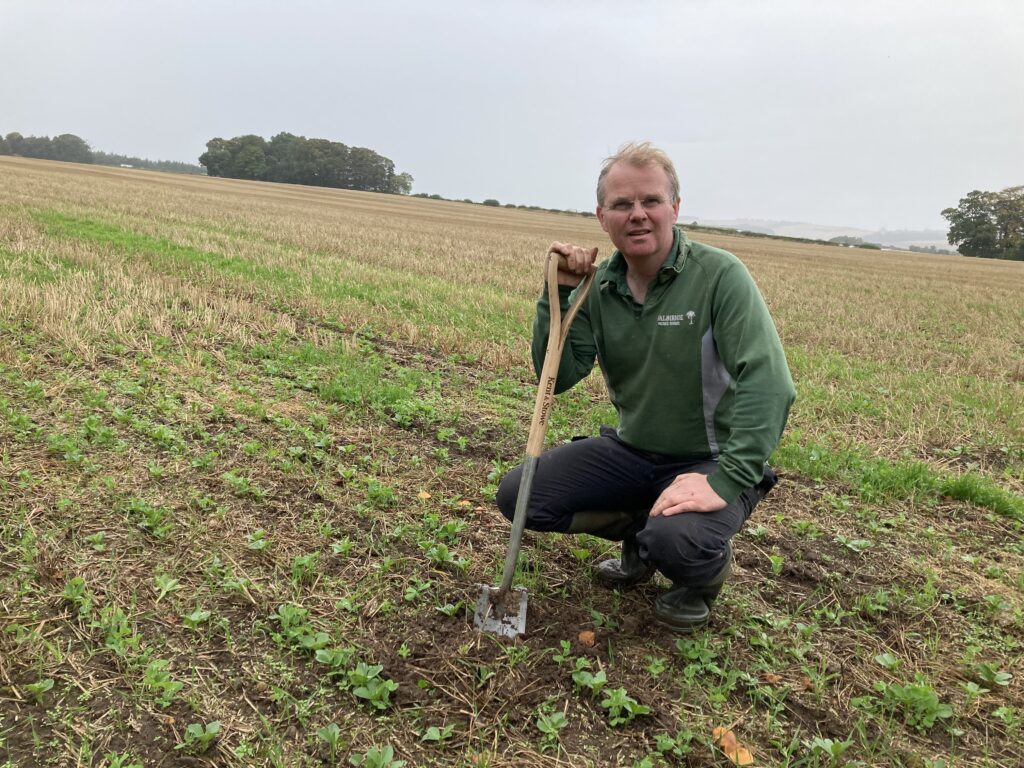Senior Knowledge Transfer Manager Henny Lowth introduces the nitrogen trials at AHDB Strategic Cereal Farms, ahead of the release of this year’s results in November.
How nitrogen behaves in farming systems is often variable and hard to pin down. With nitrogen prices stuck above pre-Ukraine-war and pre-energy-crisis levels, there is an emphasis on the nutrient in trials at our Strategic Cereal Farms.

Strategic Cereal Farm North
David Blacker, who hosts Strategic Cereal Farm North (Shipton, York), had clear ideas about what he wanted to get out of his harvest 2024 crops. But, as they say, man plans, God laughs. The UK went on to experience one of the wettest growing seasons since records began. Not good news for David’s winter wheat, which was earmarked for nitrogen use efficiency (NUE) trials.
David wants to optimise nitrogen use without unacceptable yield/quality penalties or generating lush biomass that could encourage foliar disease. The initial plan was to test the efficiency of foliar-applied liquid nitrogen compared to soil-applied nitrogen and study the impact on disease pressure.
With crop condition and growth patchy and very high soil moisture levels in the spring, the replicated tramline trials were deemed unlikely to provide a fair test of the treatments. Additionally, the crop failed to show signs of a response to the 70 kg of nitrogen applied at the first split. Even after three weeks, the crop stayed yellow and was losing tillers. A soil mineral nitrogen (SMN) test suggested that most of this nitrogen was probably lost to the atmosphere by denitrification or in drainage water.
To help “rescue” the crop, we shifted the trial approach to help the remaining nitrogen applications hit the mark. We put more focus on a slow-release foliar product, which has potential to reduce the total nitrogen dose. With roots compromised after sitting wet, the season provided a fantastic opportunity to assess the merit of foliar applications.
The farm standard nitrogen treatment was 200 kg/ha, applied to soil across three splits (adjusted for expected yield, as per RB209 guidance). Two foliar treatments were also tested. Both received 70 kg of soil-applied nitrogen at the first split, with a further 50 kg/ha applied at either the second or third split. When a split had no soil-applied nitrogen, the equivalent of 40 kg/ha of foliar-applied nitrogen was applied instead. The total applied nitrogen in the foliar approach was equivalent to 160 kg/ha. The approach was reviewed throughout the season, taking crop demand and nitrogen limits (N-max) into account.

Strategic Cereal Farm East
Our latest Strategic Cereal Farm in the East is at Morley Farms in Norfolk. The Morley Agricultural Foundation (tmaf.co.uk), which owns the land, invests in agricultural research and educational initiatives for farmers and students. The farm has hosted trials since 1965.
Host David Jones now wants to dive even deeper into trialling, with the reduction of inputs a top priority. In addition to targeting herbicides (especially to manage the farm’s rye-grass populations) and pesticides (to fine-tune the aphid/BYDV management plan), he wants to reduce nitrogen use.
Like many farms, economic optimal nitrogen application rates, NUE and yields are highly variable at Morley. David wants to pinpoint the causes of variation. Thankfully, the farm has Morley Soil and Agronomic Monitoring Study (SAMS) sites to hand. Each site is about 150 m2, with the network covering areas with high, low and variable yields (and headland sites). They are a treasure trove of data, providing long-term (2018–23) information on soil assessment results, grain nutrients, yield and management records for 29 arable sites.
NUE is already assessed at eight sites, with Old Hall Piece Field particularly interesting. It was the only SAMS field (with five SAMS sites) in winter wheat for harvest 2024 and has historically variable yields and soil electrical conductivity (EC). EC is a useful measure because it can help estimate soil texture, which is linked with NUE and yield variation. The field is hosting replicated nitrogen response trials in three contrasting management zones.
The farm will also compare variable-rate approaches (against the farm standard). Many farmers now use N-sensors, which often apply more nitrogen to areas associated with lower biomass. The theory is that this will boost growth and level the playing field. As this may not be the best universal approach, the trial will examine the best way to exploit such technologies.
Like our farm in the North, comparisons of foliar-applied, controlled-release nitrogen with a traditional soil-applied nitrogen dose at the final split have also been made. A replicated tramline trial is building on this work to unpick nitrogen responses and deliver the greatest NUE. The research will investigate all elements of NUE and consider other major nutrients (phosphorus and potassium).

Strategic Cereal Farm Scotland
In its fourth year of a six-year tenure, Strategic Cereal Farm Scotland (located near Fife) is currently the longest-running farm on our books. Host farmer David Aglen also uses multi-season trials to compare foliar nutrition with ammonium nitrate applications. Additionally, he uses in-crop measurements – derived from a Brix meter (measures plant sugar status) and SPAD (measures leaf nitrogen status) – to tailor nitrogen. A no-fungicide treatment has been successfully overlayed in these trials, which will provide valuable data on the impact of tailored nutrition on disease levels.
Releasing results
Each autumn, we release the latest results from the farm network. This year, the findings will be launched at the inaugural Strategic Cereal Farm Conference (near York on 7 November 2024). We will discuss 14 trials from across the network, including those at Strategic Cereal Farm South, which leaves the network this year. On-farm experience will be used to answer many key questions, including:
- How can nitrogen be reduced without unacceptable yield/quality penalties?
- How useful is the mechanical weed control of grass weeds?
- What is the best way to establish and destroy cover crops?
If you are unable to join us, don’t worry – our website and social channels will provide the main takeaway messages.
The 16-strong Monitor Farm network also features several NUE trials – from adapting RB209 recommendations to using foliar nitrogen, micronutrients, ‘miracle’ products and grain nutrient data. We are also currently looking at how best to exploit sensor technologies, from soil sensors to hyperspectral satellites. There will be lot to debate during this winter’s meetings.
Our new cover crops champion network is also on a NUE journey. Supported by AHDB, the champions will follow on-farm trial design principles to assess the impact of the various cover crop approaches. We will share their journeys, from establishment to termination (and beyond) online. We have also commissioned a review to help update cover crop guidance, which will consider the longer-term impacts of cover crops on soil health, including nutrient availability.
Finally, we have conducted a strategic review of RB209 in 2024, with several hundred people suggesting how to improve the guide’s format and content. NUE is a key theme (as it was in the recent review of the Recommended Lists). There is a hunger for information to help tailor nitrogen recommendations to specific systems, farms and fields. Perceived information gaps identified include nutrient availability (from soils and organic materials), optimum application strategies, as well as the use and interpretation of in-season nutrient tests and analyses.
There was also interest in broadening the scope of RB209 to include more crops, more detailed nutrient data (beyond the high-profile N, P and K, such as micronutrients) and to help calculate the carbon footprint of fertilisers. Options on how to improve the guidance will be considered by the RB209 review committee at the end of the year.
Nutrient management is one of the most important areas for AHDB investment. This is clear from farmer responses to our new research process, which receives ideas from levy-payers and turns them into projects. In fact, it has been one of the most frequently cited topics.
Our investment will continue to evolve RB209 and on-farm practice. With more projects around the corner, it is an exciting time for nutrient management.
Further information
ahdb.org.uk/strategic-cereal-farms
ahdb.org.uk/monitor-farms
ahdb.org.uk/cover-crop-champions
ahdb.org.uk/rb209-review
ahdb.org.uk/research-ideas


